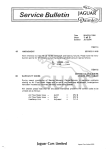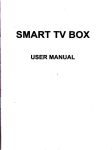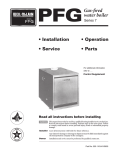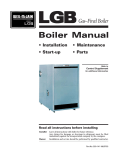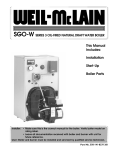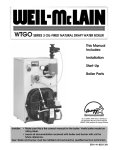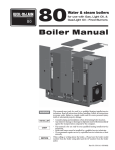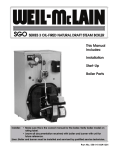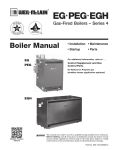Download Weil-McLain SERIES 7 PFG Specifications
Transcript
PFG Gas-fired Water boiler Series 6 Boiler Manual • Installation • Service • Operation • Boiler Parts For additional information, refer to . . . Control Supplement Read all instructions before installing Installer Leave all instructions with boiler for future reference. Any claims for damage or shortage in shipment must be filed immediately against the transportation company by the consignee. Owner Installation and service must be performed by qualified contractor. Part No. 550-110-640/0703 PFG SERIES 6 GAS-FIRED WATER BOILER — BOILER MANUAL Contents Section I: Installation Codes ......................................................... 3 Select the boiler location ............................ 3 Chimney or vent requirements ................... 4 Boiler foundation ........................................ 4 Residential garage installation .................. 5 Boiler piping connections . . ....................... 5 Filling the system ........................................ 6 Bypass piping ............................................. 8 Freeze protection ....................................... 8 Draft hood installation ................................ 9 Damper installation .................................... 9 Size and install gas piping ......................... 9 Wiring multiple zones ............................... 10 Checkout procedure ................................. 11 Section II: Service 3-11 Combustion air .............................................. 3 Installation clearances .................................. 3 When removing boiler . . ............................... 4 Placing the boiler .......................................... 5 Hydrostatic pressure test ............................... 5 Multiple zoning .............................................. 6 Recommended piping ................................... 7 External heat exchangers ............................. 8 Use with refrigeration system ........................ 8 Spill switch installation .................................. 9 Breeching erection ........................................ 9 Wiring .......................................................... 10 Install room thermostat ................................ 10 12-15 Also refer to additional instructions shipped with the boiler for specific control operation . . ............... 12 Suggested minimum service schedule for qualified service technician only ....................................... 12 Section III: Replacement Parts 16-17 Section IV: Ratings, Dimensions 18-19 Hazard definitions The following defined terms are used throughout this manual to bring attention to the presence of hazards of various risk levels, or to important information concerning the life of the product. Indicates presence of hazards that will cause severe personal injury, death or substantial property damage. Indicates presence of hazards that can cause severe personal injury, death or substantial property damage. Indicates presence of hazards that will or can cause minor personal injury or property damage. Indicates special instructions on installation, operation or maintenance that are important but not related to personal injury or property damage. The boiler contains ceramic fiber and fiberglass materials. Use care when handling these materials per instructions on page 13 of this manual. Failure to comply could result in severe personal injury. Do not use petroleum-based cleaning or sealing compounds in boiler system. Severe damage to system components can result, causing substantial property damage. Read all instructions before installing. Failure to follow all instructions in proper order can cause severe personal injury, death or substantial property damage. When calling or writing about the boiler— Please have the boiler model number from the boiler rating label and the CP number from the boiler jacket. You may list the CP number in the space provided on the Installation and service certificate found on page 11. 2 Part Number 550-110-640/0703 PFG SERIES 6 GAS-FIRED WATER BOILER — BOILER MANUAL Section I: Installation Codes Air directly from outside to boiler room: Installation must comply with all local codes, laws, regulations and ordinances. Also United States National Fuel Gas Code ANSI Z223.1-latest edition. When required, the installation must conform to Standard for Controls and Safety Devices for Automatically Fired Boilers, ANSI/ASME CSD-1. Safe lighting and other performance criteria were met with the gas manifold and control assembly provided on the boiler when the boiler underwent tests specified in ANSI Z21.13-latest edition. Canadian installations must comply with CAN/CSA B149.1 or .2 Installation Codes. The equipment shall be installed in accordance with those installation regulations in force in the local area where the installation is to be made. These shall be carefully followed in all cases. Authorities having jurisdiction shall be consulted before installations are made. • • Combustion air and ventilation openings Combustion air and ventilation openings must comply with Section 5.3, Air for Combustion and Ventilation, of National Fuel Gas Code ANSI Z223.1-latest edition, or applicable local building codes. Canadian installations must comply with CAN/CSA B149.1 or .2 Installation Codes. Provide adequate combustion and ventilation air to: • Assure proper combustion • Reduce risk or severe personal injury or death from flue gas spillage and carbon monoxide emissions. Select the boiler location • • • • • Tightly constructed buildings must be provided with openings to outside for combustion and ventilation air. These openings must be sized to handle all fuel burning appliances, exhaust and ventilation fans and fireplaces. When openings to boiler room are taken to interior spaces, provide two permanent openings: a combustion air opening within 12 inches of floor and a ventilation opening within 12 inches of ceiling. Each opening must provide a minimum free area of one square inch per 1,000 Btuh input of all appliances in room plus requirements for any exhaust fans in room. The interior space supplying combustion and ventilation air must have adequate infiltration from outside. Installation clearances Suggested minimum clearances for servicing • • • • 24 inches for cleaning and servicing, left side. 18 inches for access to controls and components, front. 48 inches from top for cleaning flueways. 6 inches on remaining sides. Required minimum clearances to combustible material in alcove installations PFG 5 thru 8: Top 42" R. Side 5" Front: Alcove Rear 5" L. Side 5" PFG 8: Provide service clearances listed above and minimum 24" between jacket and any combustible wall(s) and ceiling. Install in space large in comparison to size of boiler. • • • Part Number 550-110-640/0703 Consider all connections to boiler before selecting a location. Boiler must be installed so gas control system components are protected from dripping or spraying water or rain during operation or service. Non-combustible floor ONLY. See “Boiler foundation”, Page 4. To avoid personal injury, death or property damage, keep boiler area clear and free from combustible materials, gasoline and other flammable vapors and liquids. Do not install an exhaust fan in the boiler room. Boiler installation must assure sufficient openings in building and boiler room to provide adequate combustion air and ventilation. Consider construction tightness of building when deciding whether additional outside openings may be needed. Older buildings with single-pane windows, minimal weatherstripping and no vapor barrier often provide enough natural infiltration and ventilation without dedicated openings. New construction or remodeled buildings are most often built tighter. Windows and doors are weather stripped, vapor barriers are used and openings in walls are caulked. As a result, such tight construction is unlikely to allow proper natural air infiltration and ventilation. Air from inside building (boiler in interior room): Tightly constructed buildings must be provided with combustion air and ventilation openings to boiler room which are adequate to handle the boiler needs plus the needs of all other fuel-burning appliances, fireplaces and exhaust or ventilation fans. Combustion and ventilation openings connecting directly or by ducting to outside, or to attic or crawl spaces that freely connect with outside, must be sized as follows: 1. Outside wall or vertical ducting - one square inch per 4,000 Btuh input of all appliances in room plus requirements for any exhaust fans or other appliances in room. 2. Horizontal ducting - one square inch per 2,000 Btuh of all appliances in room plus requirements for any exhaust fans or other appliances in room. 3. All ducting must be same size as permanent openings. Minimum area dimensions of ducting must be no less than 9 square inches. 4. Other size ducting must comply with local codes. Single wall vent pipe must be at least 6 inches from combustible material. Type "B" double wall metal vent pipe - refer to vent manufacturer's recommendation for clearances to combustible material. Hot water pipes must be at least ½" from combustible material. 3 PFG SERIES 6 GAS-FIRED WATER BOILER — BOILER MANUAL Chimney or vent requirements (also refer to Breaching erection, Page 9) Venting must be installed according to Part 7, Venting of Equipment, of National Fuel Gas Code, ANSI Z223.1-latest edition and applicable building codes. Canadian installations must comply with CAN/CSA B149.1 or .2 Installation Codes. Minimum chimney or vent sizes are on page 18. A chimney or vent without a listed cap should extend at least 3 feet above the highest point where it passes through a roof of a building and at least 2 feet higher than any portion of a building within a horizontal distance of 10 feet. A chimney or vent must not extend less than those distances stated above. A lined chimney is preferred and must be used when required by federal, provincial, territorial, state or local building codes. Vitreous tile linings with joints which prevent the retention of moisture and linings made of noncorrosive materials are best. Advice for flue connections and chimney linings can usually be obtained from the local gas utility. Type "B" double wall metal vent pipe or single wall vent pipe may be used as a liner. Cold masonry chimneys, also known as outside chimneys, typically have one or more walls exposed to outside air. When any atmospheric gas-fired boiler with automatic vent damper is vented through this type of chimney, the potential exists for condensation to occur. Condensation can damage a masonry chimney. Weil-McLain recommends the following to prevent possible damage: 1. Line chimney with corrosion-resistant metal liner such as AL294C® single wall stainless steel or B-vent. Size liner per National Fuel Code ANSI Z223.1-latest edition. 2. Provide drain trap to remove any condensate. Inspect existing chimney or vent before installing boiler. Failure to clean or replace perforated pipe or tile lining will cause severe injury or death. Do not alter boiler draft hood or place any obstruction or non-approved damper in the breeching of vent system. AGA/CSA certification becomes void. Flue gas spillage and carbon monoxide emissions will occur causing severe personal injury or death. corrosion and other deficiencies which could cause an unsafe condition. c. Insofar as is practical, close all building doors and windows and all doors between the space in which the appliances remaining connected to the common venting system are located and other spaces of the building. Turn on clothes dryers and any appliance not connected to the common venting system. Turn on any exhaust fans, such as range hoods and bathroom exhausts, so they will operate at maximum speed. Do not operate a summer exhaust fan. Close fireplace dampers. d. Place in operation the appliance being inspected. Follow the lighting instructions. Adjust thermostat so appliance will operate continuously. e. Test for spillage at the draft hood relief opening after 5 minutes of main burner operation. Use the flame of a match or candle, or smoke from a cigarette, cigar or pipe. f. After it has been determined that each appliance remaining connected to the common venting system properly vents when tested as outlined above, return doors, windows, exhaust fans, fireplace dampers, and any other gas-burning appliance to their previous conditions of use. g. Any improper operation of the common venting system should be corrected so the installation conforms with the National Fuel Gas Code, ANSI Z223.1-latest edition. When resizing any portion of the common venting system, the common venting system should be resized to approach the minimum size as determined using the appropriate tables in Part 11 in the National Fuel Gas Code, ANSI Z223.1-latest edition. Canadian installations must comply with CAN/CSA B149.1 or .2 Installation Code. Boiler foundation Never install boiler on combustible flooring or carpeting, even if a concrete or aerated foundation is used. Severe personal injury, death or substantial property damage can result. 1. See Figure 1. A level concrete or solid brick pad is required if: a) There is a possibility of the floor becoming flooded. b) Non-level conditions exist. Where two or more gas appliances vent into a common chimney or vent, equivalent area should be at least equal to the area of the vent outlet on the largest appliance plus 50 percent of the area of the vent outlet on the additional appliance. When removing boiler from common venting system Failure to follow all instructions listed below can cause flue gas spillage and carbon monoxide emissions, resulting in severe personal injury, death or substantial property damage. At the time of removal of an existing boiler, the following steps shall be followed with each appliance remaining connected to the common venting system placed in operation, while the other appliances remaining connected to the common venting system are not in operation. a. Seal any unused openings in the common venting system. b. Visually inspect the venting system for proper size and horizontal pitch and determine there is no blockage or restriction, leakage, 4 Part Number 550-110-640/0703 PFG SERIES 6 GAS-FIRED WATER BOILER — BOILER MANUAL Figure 1 Boiler foundation Residential garage installation Install boiler so burners are at least 18 inches above the floor. Hydrostatic pressure test Pressure test before attaching gas piping or electrical supply. 1. Plug any necessary boiler tappings or openings. 2. Connect water supply. Fill boiler and purge all air. Test at 45 psi for more than 10 minutes. Do not leave boiler unattended. A cold water fill could expand and cause excessive pressure, resulting in severe personal injury, death or substantial property damage. 3. Check for maintained gauge pressure and leaks. Repair if found. 2. An aerated boiler foundation is recommended if any of the following conditions exist: a) Electrical wiring or telephone cables buried in the concrete floor of the boiler room. b) Concrete floor is "green." c) There is a history of the floor becoming flooded. d) Water is channeled under the concrete. Placing the boiler 1. Remove boiler from shipping pallet. Do not drop boiler or bump jacket on floor or pallet. 2. Level boiler so that air can be separated from the circulating water. Shim legs if necessary. Do not alter legs. 3. Remove front jacket door and burner access panel. Unscrew access panel screws, remove and discard shipping washers, and reinstall screws. 4. Check for proper orifice sizing from charts below. Proper orifices must be used. Failure to do so will cause severe personal injury, death or substantial property damage. 5. Level and straighten the burners. Burners must be seated properly in locating slots with their openings facing up. Gas orifices must inject down the center of the burner. Failure to properly seat burners will result in severe personal injury, death or substantial property damage. 6. Reinstall access panel. Part Number 550-110-640/0703 Leaks must be repaired at once. Failure to do so can cause boiler damage, resulting in substantial property damage. Do not use petroleum-based sealing compounds in boiler system. Severe damage to boiler will result, causing substantial property damage. 4. Drain boiler and remove testing plugs. Boiler piping connections to the heating system (refer to piping diagrams, Page 7) Failure to properly pipe the boiler may result in improper operation and damage to the boiler or building. These boilers are provided with built-in air elimination systems. 1. Install relief valve vertically in top ¾" tapping in right end section. Relief valve discharge piping must be piped near to the floor or to a floor drain to eliminate potential of severe burns. Do not pipe the relief valve discharge to any area where freezing could occur. 2. Install pressure-temperature gauge in tapping provided in left end section. 3. This boiler is for forced hot water circulation only. The circulator and expansion tank must be selected and sized according to the design requirements of the system. a) Size and install circulator. Can be installed on supply or return piping b) Size expansion tank to handle the volume of water in the system. 4. Expansion tank installations. a) Closed type expansion tanks - connect from the ¾" N.P.T. expansion tank tapping on the left end section (located just behind the supply outlet tapping) to the expansion tank using ¾" N.P.T. piping. Any horizontal expansion tank piping must pitch upward toward the tank at least 1 inch for each 5 feet of piping. b) Diaphragm type expansion tank - may be located anywhere in the system, preferably near the boiler. 5 PFG SERIES 6 GAS-FIRED WATER BOILER — BOILER MANUAL A manual or automatic type air vent must be installed in the ¾" N.P.T. tapping when a diaphragm type tank is used. The most common cause of lime deposits in boilers is inadequate expansion tank volume. If the expansion tank is too small, system water is lost from the relief valve and make-up water is added through the fill valve. Eventual section failure will result. 5. Connect the system supply piping to the supply outlet tapping on the left end of the boiler. See Figure 2a for minimum pipe size. 6. Connect the system return piping to the return tapping on the right end of the boiler. See Figure 2a for minimum pipe size. 7. Install drain valve provided with boiler on left side. The installer must provide a drain cock to drain the right (return) side of the boiler and its connecting piping. The drain cock on the left side of the boiler will not fully drain the right side. 8. Low water cut off: a) Must be installed on any PFG boiler if the boiler is located above radiation level. b) Must be installed on all PFG-8 boilers to meet ASME specifications (low water cut-off not supplied by Weil-McLain). c) May be required by certain state, local or territorial codes or insurance companies. If a low water cut-off is required, use a control designed especially for water installations. An electrode probe type low water cut-off may be located in a tee in the supply line above the boiler. 9. If the system is to be ASME inspected and approved, an additional high temperature limit is needed. Purchase and install the control in the supply outlet piping to the boiler. 10. Connect the cold water fill supply piping close to the boiler. 6 Multiple zoning 1. Zone valves: a) Refer to zone valve manufacturer's literature for wiring and application. A separate transformer is required to power zone valves. b) Provide balancing valves to adjust the flow so it is about the same in each zone. 2. Circulators: a) Zoning with circulators requires a relay for each circuit. b) Install flow control valves to prevent gravity circulation. c) Provide balancing valves to adjust the flow so it is about the same in each zone. d) Size common return and supply piping for total flow of all circulators Filling the system 1. Close manual air vents, drain cock, and automatic air vent, if used. 2. Fill to correct system pressure. Correct pressure will vary with each application. Residential systems are often designed for 12 pounds cold fill pressure. 3. Open automatic air vent one turn, if used. 4. Air must be vented for the system. Air in the system can interfere with water circulation and cause improper heat distribution. a) Open manual water feed valve. b) Starting on the lowest floor, open the air vents one at a time until water squirts out. Close vent. c) Repeat with remaining vents. d) Close manual water feed valve when correct boiler pressure is reached. 5. To purge air from system, install isolation valve in return piping. a) Connect a garden hose to the purge valve located above the isolation valve. b) Close isolation valve. Open purge valve. c) Open hand water feed valve and allow system to purge all air. If system has more than one circuit, purge each circuit separately by opening each balancing valve one at a time. d) Close purge valve. e) Open isolation valve. f) Fill the system to the correct pressure. 6. Keep the system filled by occasionally opening the air vents as in Step 4 above. Add water to make up system pressure. Part Number 550-110-640/0703 PFG SERIES 6 GAS-FIRED WATER BOILER — BOILER MANUAL Recommended boiler and system piping Figure 2a Minimum recommended pipe sizes (forced hot water) Figure 2b Piping – Closed type expansion tank Supply and return sizes refer to minimum size of pipe connected to the boiler for 20°F temperature drop between supply and return. Figure 2c Piping – Closed diaphragm type expansion tank Note: Use circulators or zone valves in each circuit for multiple circuit applications. Part Number 550-110-640/0703 7 PFG SERIES 6 GAS-FIRED WATER BOILER — BOILER MANUAL Bypass piping Use with refrigeration system BYPASS PIPING IS NOT NORMALLY REQUIRED ON ANY BASEBOARD SYSTEM Bypass piping should be used for the following installations. Bypass, supply, and return piping should be same size. The boiler must be installed so that chilled medium is piped in parallel with the heating boiler with appropriate valves to prevent the chilled medium from entering the boiler. Consult I=B=R Installation and Piping Guides. If boiler is connected to heating coils located in air handling units where they can be exposed to refrigerated air, gravity circulation during the cooling cycle must be prevented with flow control valves or other automatic means. 1. To protect: • radiant panels, plaster, etc. from high temperature water supplied from boiler, or • boiler from condensation caused by low temperature water returned from system. 2. To protect boiler from condensation formed by low water temperature returned from large water content converted gravity systems, etc., see Figure 4. Figure 4 Figure 3 Size and install gas piping In sizing the gas piping, the following factors should be considered. External heat exchangers The PFG boiler can be used with a storage tank/heat exchanger unit for domestic hot water. The boiler/tank combination should be installed and wired in accordance with the tank manufacturer's instructions, which will also show any additional components required. A zone valve or separate circulator must be installed to regulate the production of hot water. Freeze protection Use antifreeze especially made for hydronic systems. Inhibited propylene glycol is recommended. Do not use automotive, ethylene glycol or undiluted antifreeze. Severe personal injury, death or substantial property damage can result. 50% solution provides protection to about -30°F Local codes may require a back-flow preventer or actual disconnect from city water supply. Determine quantity according to system water content. Boiler water content is listed on page 19. Follow antifreeze manufacturer's instructions. 8 a) Diameter and length of the gas supply piping. b) Number of fittings. c) Maximum gas consumption (including any possible future expansion). d) Allowable loss in gas pressure from gas meter outlet to boiler. For pressure drops, see ANSI Z223-1 latest edition. Canadian installations must comply with CAN/CSA B149.1 or .2 Installation Codes. 1. Size natural gas piping from the following table. Piping must be sized to provide proper inlet gas pressure to the gas valve when boiler is operating at rated input. For natural gas, inlet gas pressure to gas valve should be a minimum of 5 inches water column and a maximum of 13 inches water column. If inlet natural gas pressure exceeds 13 inches water column, a 100 percent lock-up type gas pressure regulator of adequate size must be installed in gas supply piping and adjusted to prevent pressure in excess of 13 inches water column. To obtain cubic feet per hour, divide the input (Btu per hour) by the heating value (Btu per cubic foot). Part Number 550-110-640/0703 PFG SERIES 6 GAS-FIRED WATER BOILER — BOILER MANUAL Pipe delivery schedule Figure 5 2. PFG 6 thru 8 only (and no damper on PI boilers) - for propane gas, inlet gas pressure to gas valve should be 11 to 13 inches water column. The gas pressure regulator (furnished by the gas supplier) must be adjusted to provide lock-up pressures not exceeding 13 inches water column. Select the pipe size, tanks and regulators as required. 12. Before placing boiler in operation, check boiler and its gas connection for leaks. If boiler is to be propane fired, a conversion kit must be used. Failure to use kit, properly install kit or use kit on boiler with damper will result in severe personal injury, death or substantial property damage. 3. Remove jacket door and connect from gas valve to gas meter. 4. 5. 6. 7. 8. 9. 10. 11. Use a street elbow or an elbow and close nipple at the inlet connection of the gas valve to run gas piping through opening in jacket side panel. Follow good piping practices. Pipe joint compound (pipe dope) must be resistant to corrosive action of liquefied petroleum gases and applied sparingly only to male threads of pipe joints. A drip leg must be installed at inlet of gas connection to boiler. Where local utility requires drip leg be extended to the floor, use an appropriate length of pipe between the cap and tee. A ground joint union must be installed in the piping to provide for servicing (see Figure 5). Install manual shut-off valve outside boiler jacket as shown in Figure 5 when required by local codes. Piping must be supported by hangers, not by the boiler or its accessories. In Canada only - when manual main shut off valve is used, it must be identified by installer. Purge all air from the supply piping. Part Number 550-110-640/0703 Gas supply piping Do not check for gas leaks with an open flame - use bubble test. Failure to do so can cause severe personal injury, death or substantial property damage. a) If test pressure is less than 13.0 inches water column then close manual main shut-off valve. b) If test pressure is greater than 13.0 inches water column then boiler and gas valve must be disconnected from gas supply piping. PFG-8, as requiried by ANSI Z21.13/CSA 4.9, is equipped with a manual test valve as shown in Figure 5a. Close this valve to test boiler gas valve without supplying gas to the manifold. Figure 5a Leak test valve (model PFG-8 ONLY) 9 PFG SERIES 6 GAS-FIRED WATER BOILER — BOILER MANUAL Draft hood installation Secure the draft hood to the outlet at the top of the boiler with sheet metal screws. The bottom of the draft hood or "skirt" must have the clearance dimension above the jacket top panel as indicated on the draft hood. Do not alter draft hood. A.G.A./CSA design certification becomes void. If draft hood is altered, severe personal injury or death will occur, resulting from flue gas spillage or carbon monoxide emissions. Spill switch installation (PFG-5 ONLY) Fasten spill switch to draft hood as shown on page 16. Connect wires as shown on wiring diagram label located inside boiler door. Damper installation If damper will be installed, see Control Supplement for information. Breeching erection (also refer to chimney or vent requirements, Page 4) Connect from draft hood or damper outlet to chimney or vent with same size as breeching. Where possible, vertical venting to the outside from the draft hood or damper outlet will offer best performance. Where horizontal breeching is used, slope upward at least ¼ inch per lineal foot toward the chimney or vent and support with hangers to prevent sagging. Refer to wiring diagram label affixed to the inside of the jacket door. Bring electrical supply through proper opening in the jacket left end panel and into the electrical junction box. Wire electrical supply, circulator and thermostat as shown on the wiring diagram. For boilers equipped with control systems other than constant burner pilot, refer to separate instructions for application data. Wiring multiple zones Refer to zone valve manufacturer's literature for wiring and application. A separate transformer is required to power zone valves. Zoning with circulators requires a relay for each circuit. Install room thermostat Install room thermostat on an inside wall. Never install where it will be influenced by drafts, hot or cold water pipes, lighting fixtures, television, rays of the sun or near a fireplace. Heat anticipator in thermostat must be set to match the power requirements of the primary control to which it is connected. Refer to wiring diagram on jacket door for recommended heat anticipator setting with standard equipment. Wire the thermostat as shown. Figure 6 Typical wiring – zoning with zone valves A minimum vertical height of 3 feet of breeching before any elbow or horizontal breeching is recommended to reduce chances of flue gas spillage at the draft hood. Long horizontal breechings, excessive numbers of elbows or tees, or other obstructions that restrict the flow of combustion gas should be avoided. Breeching must not be connected to any portion of a mechanical draft system that can operate under positive pressure. Wiring For your safety, turn off the electrical power supply at the service entrance panel before making any electrical connections to avoid possible electrical shock hazard. All wiring must be installed in accordance with requirements of the National Electrical Code and any additional national, state or local code requirements having jurisdiction. All wiring must be N.E.C. Class 1. The boiler must be electrically grounded in accordance with the National Electrical Code, ANSI/NFPA No. 70-latest edition. In Canada, all wiring must be done in accordance with the CSA C22.1 Canadian Electrical Code Part 1. If original rollout thermal fuse element wire as supplied with PFG-5 boiler must be replaced, type 200°C wire or equivalent must be used. If other original wire as supplied with any PFG boiler must be replaced, type 105°C wire or equivalent must be used. The boiler is shipped with control components completely wired except for spill switch and damper (if provided). A separate electrical circuit should be used for the boiler with a fused disconnect switch (15 amp. recommended). 10 Part Number 550-110-640/0703 PFG SERIES 6 GAS-FIRED WATER BOILER — BOILER MANUAL Check-out procedure Check off steps as completed. ❏ 1. Check to make sure base insulation is secure. See "Inspect Base Insulation," page 15. ❏ 12. High limit control set to design temperature requirements of the system? Maximum high limit setting - 240 °F. ❏ 13. For multiple zones, flow adjusted so it is about the same in each zone? 5. Air purged from gas piping? Piping checked for leaks? ❏ 6. Follow operating/lighting instruction label on boiler for proper start-up. Also refer to “To Place in Operation,” page 13. 14. Thermostat heat anticipator is set properly? Refer to "Install Room Thermostat," page 10, and wiring diagram on jacket door. ❏ 15. Boiler cycled with the thermostat? Raise to highest setting. Boiler should go through normal start-up cycle. Lower to lowest setting. Boiler should go off. ❏ 16. Measure gas input (natural gas only): ❏ ❏ ❏ ❏ ❏ 2. Boiler and heat distribution units filled with water? ❏ 7. Are proper orifices installed? See page 5 for proper orifice size. Proper orifices must be used. Failure to do so will cause severe personal injury, death or substantial property damage. 3. Automatic air vent, if used, open one turn? 4. Air purged from system? ❏ 8. Proper burner flame? Refer to "Check Main Burner Flames" and "Check Pilot Burner Flame," page 13. ❏ 9. Test limit control: While burners are operating, move the indicator of the high limit control below actual boiler water temperature. The burners should go off while the circulator continues to operate. Raise the limit control above the boiler water temperature and the burners should reignite. ❏ ❏ relight, flame sensing element will sense pilot flame and the main burners reignite. b. For standing pilot systems: Turn gas knob to PILOT position and extinguish pilot flame - Pilot gas flow should stop in less than 3 minutes. Put system back into operation, see page 13. 10. Test any additional field-installed controls: If boiler has low water cut-off, additional high limit or other controls, test for operation as outlined by manufacturer. Burners should be operating and should go off when controls are tested. When controls are restored, burners should reignite. 11. To test ignition system shut-off device: a. For PI systems: Connect a manometer to outlet side of gas valve. Start boiler, allowing for normal start-up cycle to occur and main burners to ignite. With main burners on, manually shut off gas supply at manual main shut-off gas valve. Burners should go off. Open manual main shut-off gas valve. The manometer should confirm there is no gas flow. Pilot will a. Operate boiler 10 minutes. b. Turn off all other appliances served by the gas meter, including gas stove, pilot lights and gas yard lights. c. At natural gas meter measure time (in seconds) required to use on cubic foot of gas. d. Calculate gas input: e. Btuh calculated should approximate input rating on rating label. ❏ 17. Check manifold gas pressure by connecting manometer to downstream test tapping on main gas valve. Manifold gas pressure for natural gas should be 3 1/2 inches water column and for propane gas should be 10 inches water column. ❏ 18. Several operating cycles observed for proper operation? If damper is provided, see Control Suppelement for checkout procedure. ❏ ❏ ❏ 19. Room thermostat set to desired temperature? 20. Installation and Service Certificate on this page completed? 21. All instructions shipped with this boiler reviewed with owner or maintenance person, returned to envelope and given to owner or displayed near boiler? Installation and Service Certificate Boiler model __________________ Measured Btuh input ____________ Installer ________________________ (company) Series __________ CP number ___________ Date installed _______________ Installation instructions have been followed. Check-out sequence has been performed. Above information is certified to be correct. Information received and left with owner/maintenance ________________________________ (address) ______________________________ (phone) _____________________________________ (installer’s signature) Part Number 550-110-640/0703 11 PFG SERIES 6 GAS-FIRED WATER BOILER — BOILER MANUAL Section II: Service Also Refer to Additional Instructions Shipped With The Boiler For Specific Control Operation and Troubleshooting. Verify Proper Operation After Servicing. Your boiler should be inspected, cleaned and, if necessary, adjusted once a year. A qualified service agency should be called. To avoid personal injury, before servicing: 1. Disconnect electrical supply. 2. Shut-off gas supply. 3. Allow boiler to cool. Label all wires prior to disconnection when servicing controls. Wiring errors can cause improper and dangerous operation. To avoid personal injury, death or property damage, keep the boiler area clear and free from combustible materials, gasoline and other flammable vapors and liquids. Do not block flow of air to boiler. Incomplete combustion and carbon monoxide emissions can cause severe personal injury, death or substantial property damage. Do not store sources of hydrocarbons (i.e., bleaches, cleaners, chemicals, sprays, paint removers, fabric softeners, etc.) in boiler area. This can contribute to shortened boiler/vent system life. Suggested Minimum Service Schedule for Qualified Service Technician Only Beginning of each heating season: 1. Annual service call by a qualified service agency. 2. Check burners and flueways and clean if necessary. Reference "Clean Boiler Heating Surfaces" and "Clean Main Burners," page 14. 3. Visually inspect base insulation. Reference "Inspect Base Insulation," page 13. 4. Follow procedure "To Place in Operation," page 13. 5. Visually inspect main burner flames. Refer to "Check Main Burner Flames," page 13. 6. Check pilot flame. Refer to page 13. 7. Visually inspect venting system for blockage, deterioration or leakage. Reference "Inspect Venting System," page 14. 8. Check operation of low water cut-off, if used, and additional safety devices. Refer to manufacturer's instructions. 9. Check that boiler area is free from combustible materials, gasoline and other flammable vapors and liquids. 10. Check for and remove any obstruction to the flow of combustion or ventilation air to the boiler. 11. Follow instructions on circulator to oil, if oil lubricated. Over oiling will damage the circulator. Water lubricated circulators do not need oiling. Daily during heating season: 1. Check that boiler area is free from combustible materials, gasoline and other flammable vapors and liquids. 2. Check for and remove any obstruction to the flow of combustion or ventilation air to the boiler. 12 Periodically during heating season: 1. Check relief valve. Reference manufacturer's instructions on relief valve tag. 2. Test low water cut-off, if used. Blowdown if low water cutoff is float type. Reference manufacturer's instructions. Monthly during heating season: 1. Check for leaks in the boiler and piping. If found, repair at once. Leaks must be repaired at once. Failure to do so can cause boiler damage, resulting in substantial property damage. Do not use petroleum-based sealing compounds in boiler system. Severe damage to boiler will result, causing substantial property damage. 2. Visually inspect main burner flames. Reference "Check Main Burner Flames." 3. Check pilot flame. Refer to page 13. 4. Visually inspect venting system for blockage, deterioration or leakage. Reference "Inspect Venting System," page 14. 5. Check automatic air vent for leakage. If leaking, remove vent cap and push valve core in to wash off sediment that may have accumulated on the valve seat. Release valve, replace cap, and open one turn. End of each heating season: 1. Follow "Annual Shutdown Procedure," page 14. Part Number 550-110-640/0703 PFG SERIES 6 GAS-FIRED WATER BOILER — BOILER MANUAL Handling ceramic fiber and fiberglass materials This product contains fiberglass jacket insulation and ceramic fiber materials in combustion chamber lining or base panels in gas fired products. Airborne fibers from these materials have been listed by the State of California as a possible cause of cancer through inhalation. The combustion chamber lining or base insulation panels in this product contain ceramic fiber materials. Ceramic fibers can be converted to cristobalite in very high temperature applications. The International Agency for Research on Cancer (IARC) has concluded, "Crystalline silica inhaled in the form of quartz or cristobalite from occupational sources is carcinogenic to humans (Group 1).": Suppliers of fiberglass wool products recommend the following precautions be taken when handling these materials: Precautionary measures • Avoid breathing fiberglass dust and contact with skin or eyes. • Use NIOSH certified dust respirator (N95). This type of respirator is based on the OSHA requirements for fiberglass wool at the time this document was written. Other types of Inspect base insulation: The boiler contains ceramic fiber and fiberglass materials. Use care when handling these materials. See WARNING above. Failure to comply could result in severe personal injury. Make sure base insulation is secure against base front and back panels. If base insulation is damaged or displaced, do not operate boiler. Replace or reposition insulation. Failure to replace damaged insulation or reposition insulation can result in a fire hazard, causing severe personal injury, death or substantial property damage. • • • • • respirators may be needed depending on the job site conditions. Current NIOSH recommendations can be found on the NIOSH web site at http://www.cdc.gov/niosh/homepage.html. NIOSH approved respirators, manufacturers, and phone numbers are also listed on this web site. Wear long-sleeved, loose fitting clothing, gloves, and eye protection. Apply enough water to the combustion chamber lining or base insulation to prevent airborne dust. Remove combustion chamber lining or base insulation from the boiler and place it in a plastic bag for disposal. Operations such as sawing, blowing, tear out and spraying may generate airborne fiber concentration requiring additional protection. Bag for disposal. Wash potentially contaminated clothes separately from other clothing. Rinse clothes washer thoroughly. NIOSH stated First Aid. •Eye: Irrigate immediately •Breathing: Fresh air. 4. If boiler fails to start, check for following conditions: a) Loose connection or blown fuse? b) High limit setting below boiler water temperature? c) Thermostat setting below room temperature? d) Gas not turned on at meter? e) Gas not turned on at boiler? f) If above fails to eliminate the trouble, refer to Control Supplement. 5. Make sure boiler goes through several normal operating cycles. 6. Turn thermostat or operating control to desired setting. Check pilot burner flame: To place in operation: 1. Make sure boiler is filled with water. 2. Follow lighting/operating instructions on boiler. For propane boilers only: • • • • Your propane supplier mixes an odorant with the propane to make its presence detectable. In some instances, the odorant can fade, and the gas may no longer have an odor. Propane gas can accumulate at floor level. Smell near the floor for the gas odorant or any unusual odor. If you suspect a leak, do not attempt to light the pilot. Use caution when attempting to light a propane pilot. This should be done by a qualified service technician, particularly if pilot outages are common. Periodically check the odorant level of your gas. Inspect boiler and system at least yearly to make sure all gas piping is leak-tight. Consult your propane supplier regarding installation of a gas leak detector. There are some products on the market intended for this purpose. Your supplier may be able to suggest an appropriate device. 1. Proper pilot flame a) Blue flame. b) Inner cone engulfing pilot flame sensor. c) Pilot flame sensor glows cherry red. 2. Improper pilot flame a) Overfired - flames large and lifting or blowing past pilot flame sensor. b) Underfired - flame small; pilot flame sensor not engulfed by inner cone. c) Lack of primary air - flame tip yellow. d) Pilot flame sensor not heated properly. Figure 7 Typical pilot burner flame 3. If boiler starts, go to Step 5. If boiler fails to start, go to Step 4. Part Number 550-110-640/0703 13 PFG SERIES 6 GAS-FIRED WATER BOILER — BOILER MANUAL seat burner will result in severe personal injury, death or substantial property damage. Check main burner flames: 1. Proper burner flame - Yellow-orange streaks may appear - caused by dust. 2. Improper flame a) Overfired - Flames large. b) Underfired - Flames small. c) Lack of primary air - Yellow tipping on flames; sooting will occur. Figure 8 Typical main burner flame 13. Reinstall draft hood, damper (when used), and breeching. 14. Follow "To Place in Operation" procedure. NOTE: Excessive sooting indicates improper combustion of the gas. Call a qualified service agency or your local gas utility to check for proper combustion and make any necessary adjustments. Clean main burners: 1. Vacuum or brush burners to remove dust and lint. When reinstalling, burner tubes must be seated in their locating slots with the openings facing up. Gas orifices must inject down center of burner. Failure to properly seat burner will result in severe personal injury, death or substantial property damage. Annual shut-down procedure: Inspect venting system: 1. Check venting system at least once a month during heating season. With boiler in operation (at least 5 minutes), hold a candle or match below lower edge of draft hood "skirt." If flame is undisturbed or leans under skirt, vent system is functioning properly. If flame is extinguished, flickers, or reduced while flame is pushed out side skirt, the vent system must be checked for obstructions or other causes of improper venting. 2. Inspect all parts of venting systems for deterioration from corrosion, physical damage, sagging, etc. Correct all conditions found. 3. Verify damper, if used, is open when burner ignites. For additional information, see Control Supplement. Clean boiler heating surfaces The boiler contains ceramic fiber and fiberglass materials. Use care when handling these materials per instructions on page 13 of this manual. Failure to comply could result in severe personal injury. 1. Follow shut-down procedure. 2. Remove breeching, draft hood and damper (when used). Remove jacket top panel. Turn back jacket insulation to expose collector hood. 3. Remove collector hood. Clean excess boiler cement from collector hood and cast iron sections. 4. Remove radiation plates. 5. Remove burners from base of boiler. Follow "Clean Main Burners," page 14, to thoroughly clean burners. 6. Place newspaper in base of the boiler to collect soot that will fall. 7. With a wire flue brush, clean between the sections. 8. Remove newspaper and soot. Vacuum or brush base and surrounding area to remove soot. 9. Reinstall radiation plates. 10. Reinstall collector hood. Seal with boiler cement. 11. Reinstall insulation and jacket panel. 12. Reinstall burners. When reinstalling, burner tubes must be seated in their locating slots with the openings facing up. Gas orifices must inject down center of burner. Failure to properly 14 1. Follow lighting/operating instructions label on boiler. 2. DO NOT drain the system unless exposure to freezing temperatures will occur. If antifreeze is used with system, do not drain. 3. If the complete boiler and piping system must be drained to avoid freezing, then a means must be provided for draining water from BOTH ends of the boiler at or below the level of the return tapping. A boiler drain cock is provided by Weil-McLain on the left side of the boiler only. Special servicing instructions Failure to use PFG Series 6 intermediates or to properly seal sections per Figure 9 can cause flue gas spillage or carbon monoxide emissions, resulting in severe personal injury, death or substantial property damage. PFG Series 6 intermediate sections have smooth ground sealing surfaces. These sections must be used if replacing intermediate sections. End sections have rope groove in place of smooth ground sealing surface. If replacing any section (see Figure 9): - Approved RTV silicone sealant (Dow Corning 700 or 732 or G.E. 808 or 108) must be used to seal between intermediates. - Cope seal must be used to seal between intermediates and end sections. Figure 9 Section assembly Part Number 550-110-640/0703 PFG SERIES 6 GAS-FIRED WATER BOILER — BOILER MANUAL Common problems and possible solutions Part Number 550-110-640/0703 15 PFG SERIES 6 GAS-FIRED WATER BOILER — BOILER MANUAL Section III: Replacement Parts The boiler contains ceramic fiber and fiberglass materials. Use care when handling these materials per instructions on page 13 of this manual. Failure to comply could result in severe personal injury. To avoid personal injury, before replacing any parts on the boiler: 1. Turn off power. 2. Shut off gas supply. 3. Allow boiler to cool. 16 Part Number 550-110-640/0703 PFG SERIES 6 GAS-FIRED WATER BOILER — BOILER MANUAL Replacement Parts Part Number 550-110-640/0703 17 PFG SERIES 6 GAS-FIRED WATER BOILER — BOILER MANUAL Section IV: Ratings and dimensions Ratings DOE Standard equipment Factory Fire Tested Insulated Extended Jacket Built-In Air Separator Draft Hood (Shipped in separate carton) Combination Gas Valve Non-Linting Pilot Burner Aluminized Steel Burners Combination Relay Receptacle and 40 VA Transformer Relay High Limit Control Spill Switch (PFG-5 only) Rollout Thermal Fuse Element (PFG-5 only) 30 P.S.I. Relief Valve (shipped in separate carton) (boiler sections tested for 50 P.S.I. water working pressure) Combination Pressure-Temperature Gauge (shipped in separate carton) Drain Valve (shipped in separate carton) 18 PIDN Intermittent Electronic Ignition System Automatic Vent Damper PIN Intermittent Electronic Ignition System SPN Constant Burning Thermally Supervised Pilot System Thermocouple Part Number 550-110-640/0703 PFG SERIES 6 GAS-FIRED WATER BOILER — BOILER MANUAL Dimensions * Locate manual main Shut-Off Gas Valve (where required) according to local utility requirements. Part Number 550-110-640/0703 19 PFG SERIES 6 GAS-FIRED WATER BOILER — BOILER MANUAL 20 Part Number 550-110-640/0703




















